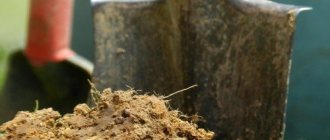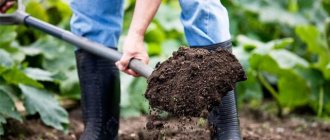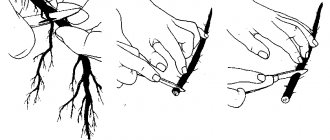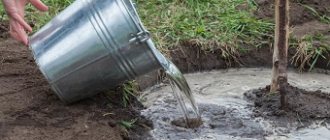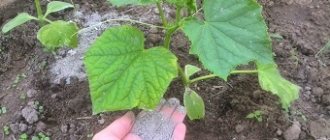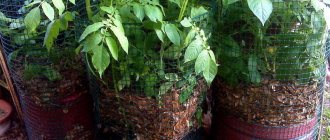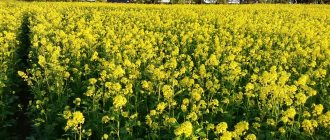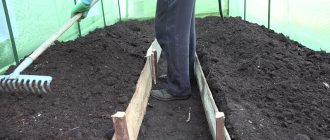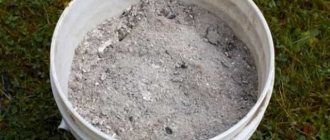Why is it so important to fertilize the soil for potatoes in the fall?
It is necessary to fertilize the soil immediately after harvesting in order to restore its fertility, because the formation of green mass and tubers requires a lot of nutrients.
During the autumn-winter period, organic matter has time to rot, and mineral fertilizers partially decompose, forming easily digestible compounds. This is the right time to disinfect the soil and normalize its acid-base balance. Less fertilizers need to be added to the soil prepared in the fall, and their effect will be stronger.
Root and foliar feeding after planting to increase yield
During the potato growing season, root and foliar fertilizers are used.
Root
- At the beginning of growth, potatoes need nitrogen, which is abundant in manure. Up to 250 g of rotted manure is added to the root at a time.
- Nitrogen can also be added using mineral fertilizers. If the culture does not grow, 1 tbsp. a spoonful of urea is diluted in 10 liters of water. 0.5 liters of solution is poured into each bush.
- Bird droppings, which are diluted with water 1:20 and watered at the root, will help increase productivity.
Fertilizers are taken under the roots before hilling the potatoes. Before the procedure, the soil is slightly loosened, then the nutrients will reach the root system faster.
Foliar
Foliar fertilizers are applied after the first hilling. It is best to do this in the evening so that the sun does not leave burns on the leaves.
Nettle infusion
Nettle infusion will help increase the crop's immunity to adverse conditions.
- Nettles are chopped finely.
- Fill with water.
- Leave until the mixture ferments.
- Everyone is filtered.
- Add 10 liters of water to 1.5 liters of infusion.
- Potatoes are sprayed with the product.
Phosphorus
Stimulates the formation of inflorescences.
- 5 tbsp. spoons of superphosphate;
- a bucket of water;
- process 10 sq. m plot.
Potassium humate
Increases productivity. It is carried out when 4 leaves are formed with an interval of 2 weeks.
- 10 liters of water;
- 2 g Humate+7.
- 3 liters of solution are used per hundred square meters.
Soil preparation
Potatoes are demanding on soil fertility and love a thick layer of humus. To ensure such conditions, organic trenches begin to be prepared in the fall. This method allows you to get maximum yield even in small areas, because the plant roots receive natural heat, drainage and nutrition.
How to Prepare Organic Potato Trenches
Dig grooves 35-40 cm deep and wide. A passage of 60-80 cm is left between the trenches.
Organic waste is placed at the bottom of each groove: flower stems, weeds, mown grass, pumpkin tops, fallen leaves. Sprinkle earth on top. To speed up decomposition and enrich the soil with beneficial bacteria, microbiological preparations are used - “Shine”, “Vostok”, “Baikal”.
In a few months, organic matter has time to ferment, and the soil becomes looser and more nutritious.
How to fertilize potatoes before hilling
The first hilling is carried out when the plant reaches a height of 10-15 cm. It promotes the appearance of new roots on the stems, which will increase the absorption of nutrients by the plant. Perhaps the fertilizers applied before planting will not be enough for the young plant, and this will be noticeable in appearance. Such plants look frail, with weak leaf color.
Before the first hilling, granular or powder fertilizers can be scattered between the rows and then incorporated into the soil. Or, after loosening the rows, apply liquid fertilizing and then hill up the plants well. Foliar feeding is effective and should be carried out before flowering and budding.
What can be used for feeding?
- Chicken droppings . The mother infusion is diluted in a ratio of 1:10 and watered between the rows. Granulated is used according to the instructions. The dosage should be strictly observed so as not to burn the plants.
- Herbal infusion . Nettles, weeded weeds, and mown grass are placed in a barrel, filled with water and left to ferment for 5-7 days. After a few days, the infusion will ferment, which means it is ready for use. 1 liter of infusion is diluted in 10 liters of water and watered between the rows.
- Mullein . Place mullein in a 20-liter tank, add a handful of superphosphate and 2 handfuls of ash. Stir and leave for several days. Then dilute 1 liter of infusion in 10 liters of water and pour the soil between the potatoes.
- Ammonium nitrate . It can be scattered over the surface and then incorporated into the soil during hilling. Or dilute 20 g in a bucket of water and water the rows.
- Urea . Dissolve 300 g of urea in a bucket of water. This solution is best used for foliar feeding. Spray the plants with the solution; the fertilizer will be better absorbed from the leaves and reach the root system faster.
- Complex mineral fertilizers , which contain phosphorus, potassium, manganese and boron. Dissolve them according to the instructions on the bag and spray (foliar feeding).
- Humates are applied at a rate of 3 liters per hundred square meters as soon as the leaves form 5 leaves.
Root feeding can be carried out at any time of the day, but with subsequent embedding into the soil. It is good to carry out such fertilizing before the rain. And foliar feeding (spraying) is carried out in the evening after sunset or in cloudy weather. When spraying, follow safety precautions and wear protective clothing.
Autumn feeding rules
Autumn soil preparation for planting potatoes includes:
- cleaning the area from tops and weeds;
- soil leveling;
- sowing green manure;
- digging up the soil;
- application of organic and mineral fertilizers.
Soil preparation
To begin with, the area is cleared of tops. The green mass of nightshades (potatoes, tomatoes, peppers and eggplants) is burned, the tops of cucumbers and zucchini can be sent to a compost pit, after watering with a lime solution - 1 kg of substance per 10 liters of water.
Weed residues are potentially dangerous for the future harvest. In addition to the fact that they shade the area and consume nutrients from the soil, weeds attract pests (wireworms) and can be carriers of diseases. To get rid of rhizomes, the field is plowed or manually dug. Additionally, the soil can be treated with herbicides.
They dig up the soil to increase its water and air permeability, saturate it with oxygen and get rid of the larvae of pests hidden in the lower layers of the soil. Sometimes two autumn diggings are required with an interval of 30-45 days, especially if the soil is too heavy.
Organic fertilizers
The most popular organic materials are manure, compost and ash. The micro- and macroelements in them are balanced by nature itself and are easily absorbed by plants.
In order not to attract pests preparing for winter that flock to the heat generated by manure, it is better to apply it in late autumn, after the first frost, after mixing it with compost. In addition to the usual mullein, you can use horse and rabbit manure. Pork preys for up to 18 months, so it is added only in exceptional cases.
Fresh wood recently cleaned from livestock is not suitable for autumn digging, as it contains seeds of weeds that will sprout in the spring.
Attention! Avoid fertilizing with organic matter if the soil is infected with potato nematode.
Minerals and green manures
In the fall, substances are introduced that dissolve more slowly and are not washed out of the soil longer:
- "Nitroammophoska";
- urea;
- "Superphosphate".
Follow the general rule: it is better to slightly underfeed potatoes than to allow an excess of nutritional compounds. For example, manure reduces the rate of mineral nitrogen preparations; “Superphosphate” is not mixed with urea. You should be careful when combining inorganics with ash.
How to fertilize the soil for potatoes in the fall without using special means? A gentle way to enrich the soil is to sow it with green manure. These plants are not grown for harvest, but as organic fertilizer. Green manure does not allow weeds to develop, protects the soil from dehydration and weathering, and prevents deep freezing of the soil.
Mustard, rye, rapeseed and phacelia are optimal for potatoes - they sprout quickly and gain mass.
Normalization of acidity
With the help of fertilizers, you can even out the pH of the soil: acidify the alkaline soil with leaf compost or peat, lime the acidic soil with ash.
To determine acidity, different methods are used:
- Pay attention to wild vegetation. Strongly acidic soils are preferred by plantain, pansy, horse sorrel and horsetail, while neutral and slightly acidic soils are preferred by clover, nettle, field bindweed, and coltsfoot.
- Check the reaction to vinegar. Soil with a neutral pH will bubble up.
- Use commercial strips to test acidity.
Choosing a landing site
In order for the tubers to germinate well and not rot, you need to choose the right place. Potatoes do not tolerate excess moisture and stagnant water. If the site is located on a hill, this is good. If in a lowland where water stands for a long time in the spring, then you need to think about how to drain it. These could be drainage ditches or imported soil to level the area.
The ideal soil for potatoes is loose . These are soils mixed with sand. This is both a plus and a minus, since sandy and sandy loam soils do not retain nutrients well, especially potassium, which the crop needs in large quantities.
The soil for potatoes should be prepared in the fall for several reasons:
- time must pass for the soil to rest and the applied fertilizers to pass into an accessible form;
- During the winter, harmful microflora can be destroyed with the help of chemicals introduced in the fall;
- If you use fresh manure as a top dressing, it will rot over the winter and the nutrients will be available to the plants.
The highest yields can be obtained by developing the site for the first time. The nutrient content in the soil is high and the plants feel good. It is also important that there are no microorganisms in the soil that attack the tubers. The longer a plant remains in one place, the greater the risk of soil contamination by fungal diseases.
When developing a new area for planting, the yields will be high at first.
It is not advisable to plant potatoes after:
- tomatoes;
- bell pepper.
These species share common pests, so the situation will only get worse. You will have to make every effort to cure the soil of pathogens.
Potatoes grow well after:
- beans and other legumes;
- cabbage;
- cucumbers
If you have time and desire, after harvesting you can sow the area with green manure. But not just any kind, but those that not only accumulate nutrients in the soil, but also disinfect it:
- white mustard;
- rape;
- oilseed radish;
- rapeseed.
Green manure destroys fungal flora and insect larvae, loosens the soil, and enriches it with useful microelements.
Types of fertilizers
Fertilizers have special properties and must be applied to the soil in certain quantities and combinations. We offer options for fertilizing potatoes in the fall.
Cow dung
The advantages of mullein are high nutritional value, availability and relative cheapness. You can agree on the supply of cow manure at almost any farm or farmstead.
The chemical composition of cow manure includes a large amount of nitrogen (especially bedding mullein with rotted remains of straw and hay), phosphorus, potassium, calcium and magnesium.
According to the degree of decomposition they are distinguished:
- fresh,
- semi-rotted, obtained after 3-4 months of storage;
- humus, the formation of which takes 6-12 months.
Fresh manure is rich in ammonia and often contains worm eggs and other pathogenic microflora. To get rid of parasites, mullein is composted or infused. The temperature inside the compost heap reaches 65°C, and helminth eggs die, and the percentage of weed germination decreases. Therefore, the semi-rotted type is considered the most valuable - such biomass is loose and small, it contains a lot of nutrients.
Humus looks like a homogeneous, dark mixture with a distinct earthy odor. It is good for growing seedlings, mulching and as a filler for holes during and after planting.
Reference. It is usually recommended to apply 5 kg of manure per 1 m², but these norms are acceptable if fertilizing is done once every 3-4 years. When applying fertilizer annually, 500 g to 1 kg is sufficient, depending on the type of soil.
Bird droppings
Chicken droppings are most effective as a fertilizer for potatoes, because they are less watery than the excrements of other poultry. This is a strong and fast-acting remedy, so it must be used with caution.
Benefits of fertilizer:
- bird droppings contain 3 times more nitrogen and phosphorus than cow droppings, and contain potassium in the form of highly soluble salts, manganese, sulfur, etc.;
- has a prolonged effect, so it is enough to apply it once every 2-3 years;
- increases crop resistance to late blight, scab, root rot and other infectious diseases.
Composted chicken manure is added to the soil for potatoes. To do this, it is sprinkled with plant residues, peat and soil and left to ripen throughout the summer. The application rate per 1 m² is 500-700 g of litter.
Reference. Specialized stores sell dried and sterilized chicken manure products in the form of granules, balls and powder. They are safer than fresh fertilizer.
Compost
This product of natural decay is the most affordable fertilizer , because you can make it yourself from almost any organic waste: food debris, straw and hay, sawdust, tops of root crops. To speed up ripening, special catalyst substances are added to the compost, and mineral additives are added to enrich the composition.
Attention! In order not to make the compost pit a breeding ground for fungal and bacterial diseases, you should not put nightshade tops (potatoes, tomatoes, eggplants, peppers), apples, or spoiled bread in it. Fruits with large stones and weeds with seed pods and roots should be avoided.
Half-rotted compost is suitable for autumn digging; over the winter, the remains will have time to completely decompose. It is applied according to the principle of a layer cake, alternating with manure, straw or fresh mown grass, and 10-15 cm of ordinary soil is poured on top and watered with water or a solution of microbiological fertilizers.
Wood ash
The main purpose of this fertilizer is to alkalize acidic soils and increase plant resistance to disease.
The composition largely depends on the initial raw materials:
- straw ash, especially after burning sunflower and buckwheat stalks, leads in potassium content - 25-35%;
- ash from birch and pine firewood is the richest in calcium - 30-40%.
Other nutrients include phosphorus in easily digestible form, manganese, magnesium, sulfur, boron, iron, molybdenum.
Ash should not be used simultaneously with nitrogen fertilizers, such as manure, as it activates the activity of nitrogen-fixing bacteria. Its best “companions” are humus (compost) and peat.
The long-term effect of adding ash is especially noticeable on heavy clay soils, but it is washed out faster from sandy soil.
Reference. Ash is used in crumbly form and as a solution - 100-150 g per 10 liters of water. In autumn, apply 60-100 g of fertilizer per 1 m² of soil.
Phosphorus fertilizers
The most popular phosphate fertilizers are:
- Phosphorite flour . Contains 19-30% calcium phosphate. Suitable only for podzolic and peaty soils and applied with acidic fertilizers, for example, ammonium sulfate or manure.
- Simple and double "Superphosphate" include 16-20% and 43-46%, respectively, of water-soluble calcium phosphate. Can be used on all types of soil.
- Combined fertilizers – “Nitrophoska” and “Nitroammofoska”. They also contain nitrogen and potassium.
For autumn soil preparation for potatoes, choose “Nitroammophoska” (30 g per 1 m²), as well as simple (20 g) or double (10 g) “Superphosphate” in combination with nitrogen and potassium fertilizers.
Important! Phosphates work better in tandem with potassium fertilizers, so they need to be applied at the same time.
Urea
The academic name of the fertilizer is urea. Used in agriculture since the 18th century to enrich the soil with nitrogen.
Urea is highly soluble in water, but is not washed out of the soil by precipitation, so it requires careful use. Most often, such fertilizer is applied inside the hole when planting tubers, and then in the form of root and foliar dressings during the summer. In autumn, it is used immediately after harvesting to avoid the formation of harmful compounds at low temperatures.
This is interesting:
How to fertilize cucumbers with mullein.
Rules for feeding cucumbers with chicken droppings in open ground and greenhouses.
Fertilizing tomatoes with urea: why it is needed and how to do it.
Nitrate fertilizers
Nitrates contain nitrogen in the form of nitric acid - nitrates, they quickly dissolve in the soil. In the fall, after harvesting, sodium nitrate is used primarily as a fertilizer for potatoes.
The disadvantage of such fertilizers is that they are quickly washed out of the soil , so it is recommended to apply them in the spring, shortly before sowing.
Reference. Nitrate fertilizers are physiologically alkaline, therefore they are effective on acidic soddy-podzolic soils, and should be avoided on saline soils and solonetzes.
Ammonia fertilizers
These include:
- ammonium nitrate in granules;
- aqueous ammonia, or ammonia water;
- nitrogen-phosphorus fertilizers - “Ammophos” and “Diammophos”.
Nitrogen in ammonia (ammonium) form is highly soluble in water and quickly absorbed by plants. It evaporates just as quickly from the soil, so ammonia substances are introduced into the soil to a depth of 3-4 cm and sealed.
Potash
Potatoes love potassium, but not all potassium fertilizer formulas are equally beneficial for the crop.
Potassium chloride slows down plant growth and reduces the amount of starch in tubers, so it is better to choose sulfate forms for fertilizing. But if you apply chlorine-containing potassium fertilizers in the fall, they will disinfect the soil and be partially washed out of it by spring, without harming the plantings.
Potassium sulfate (potassium sulfate) enriches the soil with sulfur and has a positive effect on the keeping quality of tubers. However, this form is not suitable for neutral and alkaline soils.
The importance of fertilizing potatoes when planting in a hole
Potatoes require a complex of nutrients for normal development: nitrogen, potassium, phosphorus, magnesium, zinc, copper, manganese. During growth, the crop absorbs many elements from the soil.
Thanks to feeding:
- productivity increases;
- the quality and taste of tubers improves;
- the required amount of nutrients is retained in the soil;
- Plant immunity to diseases increases.
For the full development of a vegetable, nitrogen, phosphorus and potassium are required. Nitrogen helps increase green mass, phosphorus and potassium contribute to the formation of high-quality tubers.
Potatoes need:
- at the beginning of the season - nitrogen;
- during flowering - magnesium, potassium and phosphorus.
During growth and development, the vegetable consumes a large amount of nutrients from the soil. After each harvest, the soil becomes less nutritious, becoming more depleted every year. Therefore, the land must be fertilized so that it always remains fertile, otherwise next year it will be possible to harvest a weak potato harvest.
According to calculations by agronomists, 1 kg of potatoes extracts from the soil: 5 g of nitrogen; 10 g potassium; 2 g phosphorus; as well as zinc, copper, manganese, boron and other trace elements.
To get a rich harvest every year, it is necessary to regularly restore the fertility of the soil by adding fertilizers to it.
Potatoes absorb nutrients from the soil throughout the growing season, especially during bud formation and flowering. Therefore, it is very important to fertilize root crops when they are planted in the ground.
Rules for selecting fertilizers for different types of soil
The main characteristics of the soil are the presence of humus, soil structure and acidity. To answer the question of how to fertilize a potato field in the fall, you must first determine the type of soil.
Clay soil
Clay soils are heavy and dense, they warm up slowly, do not allow moisture to pass through well and, as a rule, have an acidic environment. Such properties have a bad effect on the potato harvest.
Liming helps reduce acidity. To do this, slaked lime or “fluff”, dolomite flour, wood ash, ground chalk and crushed eggshells are added to the soil in the fall. When using lime, additional fertilizer with manure will be ineffective, so fertilizing with organic matter is postponed until spring.
To make the soil more air- and water-permeable, loosening materials are added: sand, light leaf humus, peat at the rate of 1 bucket per 1 m².
Loam
This type of soil is distinguished by:
- granular-lumpy structure;
- sufficient amount of nutrients;
- high level of water permeability and breathability.
Despite the presence of heavy and dense clods in the soil, loam is favorable for the cultivation of vegetable crops.
To maintain optimal conditions, loamy soils need to be enriched with organic matter - compost and manure - in the fall. Sodium nitrate is an effective mineral fertilizer.
Sandy
The main disadvantage of sandy soils is that they are poor in humus (humus content is about 1%), do not retain moisture well, overheat during the day and cool quickly at night. But this loose soil is easy to process.
To get a good potato harvest, compacting components are added to sandy soils: peat, clay flour and compost. Once every 2 years, rotted manure is placed in the deep layers. Potassium magnesium (potassium magnesium sulfate) helps compensate for the lack of magnesium.
Reference. Organic and mineral fertilizers must be applied regularly, as they quickly decompose in sandy soil.
Chernozem
Chernozem is rich in humus (up to 15%), permeable to air and moisture . Due to the high calcium content (70-90%), the soil reaction is neutral or close to neutral. Such soil has natural fertility, so it can be used as a fertilizer in itself.
If the chernozem is of low quality (only 4% humus) or the soil is depleted, it can be additionally fed with nitrogen and phosphorus fertilizers - potassium sulfate or ammonium sulfate. Once every 5-6 years it is useful to give the soil a “rest” by sowing green manure.
Green manure for potatoes
Digging with the addition of organic and mineral compounds can be replaced by the use of green manure plants. Mowing them in early spring helps enrich the top layer of soil with useful nutrients.
Green manures serve as natural fertilizers and a means of harmonizing the composition and structure of the soil. Improves its fertility.
- Legumes saturate the beds with nitrogen. In combination with asteraceae and cruciferous plants, they prevent erosion and the spread of weeds.
- Simple combinations of legumes and cruciferous crops in plantings help loosen dense soils. In combination with Asteraceae, they successfully reduce the population of nematodes. Plants from the mustard moth family remove phosphoric acid salts from the ground.
- Cereal green manure mixed with cruciferous vegetables prevents mineralization and saturates the soil with nitrogen.
- Crescent and rapeseed are the easiest green manures to grow. After such plants, the amount of organic compounds in the soil increases. Oilseed radish prevents weathering and the breakdown of mineral salts.
What fertilizers should not be applied to potatoes in the fall?
For the winter, you cannot apply fertilizers that:
- contain spores of pathogenic microorganisms - fresh manure, compost from infected tops and weeds;
- disrupt the balance of micro- and macroelements in the soil.
When combining various fertilizers, you should not mix some substances:
- alkaline media (ash, lime, chalk) reduce the effectiveness of nitrogen fertilizers (ammonium nitrate, ammophos, ammonium sulfate);
- manure contains a lot of nitrogen, so it does not require additional application of nitrogen-containing substances;
- ammonium nitrate in combination with dry organic matter (peat, straw, sawdust) can lead to spontaneous combustion.
The most common mistakes when applying autumn fertilizers:
- soil pH is incorrectly determined;
- the dosage is violated;
- expired fertilizers are used;
- Recommendations for combinations of substances are not followed.
Pre-sowing treatment in spring
All efforts spent on preparing the soil for planting potatoes are subordinated to one goal - growing a healthy crop.
Did you know? Potatoes can be poisonous to humans. For poisoning, it is enough to eat 2-3 berries from a bush or 1 kg of green, unpeeled tubers.
To achieve this, pre-treatment of the land provides:
- better soil moisture;
- giving it looseness for high-quality aeration;
- crushing large earthen lumps that impede the development of roots in potato bushes;
- uniform distribution of fertilizers throughout the area;
- weed removal;
- land disinfection.
The soil, which has rested over the winter, needs to be refreshed so that it is finally ready before planting potatoes.
Plowing
Experienced gardeners claim that spring plowing, carried out taking into account the characteristics of the soil, contributes to a better harvest. To do this, it is worth remembering that deep moldboard (up to 30–35 cm) processing is suitable for:
- chernozems;
- floodplain soils;
- peat soils.
But sod-podzolic areas are plowed with plows without moldboards or with subsoilers, loosening the soil to a depth of 25–30 cm.
Harrowing
This procedure in the spring is necessary to retain moisture in the soil for the future harvest. During harrowing, the soil on the surface of the earth is crushed, and its ball prevents evaporation. For best results, the procedure should be carried out with heavy harrows.
In addition to moisture retention, such loosening of the soil allows for high-quality heating of the soil, and oxygen saturation ensures the vital activity of beneficial microorganisms.
However, it is important to choose the right time for harrowing. If it is carried out too early, the wet soil will become even more compact due to plowing. If you are late, the earth will lose moisture and become covered with a dry crust.
Important! The optimal time for harrowing the garden is when the clods of earth begin to acquire a grayish color.
Cultivation
Cultivation differs from the previous procedure in that the tool loosens the soil, but does not turn over the soil layers, so moisture is retained.
This is the last stage of preparing the soil for planting potatoes. Inter-row cultivation is recommended for this crop. It is carried out first before planting, and then, as needed, it is organized during the process of potato growth.
During the first spring digging, cultivation is done at a depth of 6–16 cm: the faster the soil dries, the deeper the plowing is done. In the future, the standard loosening depth in such cases is 12 cm, but if weeds are actively growing on the site, then the treatment is done deeper, up to 14 cm.
Potatoes can be grown successfully in many soils suitable for the plant. More important are the illumination of the designated area and sufficient humidity. Exceeding the norm of the latter has an extremely negative effect on plant development. The likelihood of fungal and bacterial diseases, including late blight, also increases.
Autumn plowing of the soil is carried out with the aim of creating a deep, loose and well-ventilated layer of soil in which the required amount of moisture will accumulate and remain. It should be noted: no other agricultural work (watering, fertilizing...) can provide sufficient oxygen.
First of all, you need to understand which soil is most suitable for growing potatoes. Obviously, there are places where, despite all the work and expense, potatoes will not grow. Heavy clay soils with a lot of moisture are absolutely unsuitable. Lowlands where water can accumulate are excluded. The soil in which potatoes will feel “at home” is light, sandy loam, as loose as possible.
If your site meets all the requirements, it is enough to properly prepare the soil for planting potatoes in order to get excellent yields. What is the secret of a good harvest?
- good soil composition;
- preparing root crops for planting;
- productive variety;
- proper care.
When the land is ready for planting, you need to take care of the planting material. Tubers need to be planted not only in well-prepared soil, but also sufficiently warm and dried soil, otherwise they may freeze or rot. You can plant a whole tuber or divided in half. Before planting, potatoes should be carefully inspected and rotten or diseased tubers should be removed.
Potatoes should look healthy, free from defects, mold and rot. Root vegetables weighing from 50 to 90 grams are ideal. Potatoes should be dried before planting. If you do not have enough material for planting, then the tubers can be divided, but in such a way that each segment has sprouted eyes. Divide immediately before planting.
Proper preparation of the soil for planting potatoes and preparing crops for planting are, let us remind you once again, the most important stages and this process should be considered in general.
Potato soil loves oxygen. What does it mean? First of all, it is necessary to enrich the soil with oxygen by digging. This is done twice a year - in the fall, after harvesting and thoroughly cleaning the soil from grass and remaining tops, and also in the spring before planting. Preparing the soil for planting potatoes in the spring was discussed at the beginning of the article, but do not forget that in the fall it is also necessary to take care of the future harvest.
Potatoes are a photophilic plant; a lack of sunlight can lead to stretching of the tops, wilting of the foliage, and poor formation of inflorescences. Therefore, you need to select a well-lit place for planting this vegetable.
It is not recommended to plant potatoes in one place year after year. It is necessary to adhere to the rules of crop rotation so that the plant does not suffer from diseases and harmful insects, and the soil is not depleted.
| Add organic matter The ideal fertilizers for potatoes are rotted compost or manure. Humus will also work. The application rate depends on the fertility of the soil; under normal conditions, a bucket per 1 square meter is applied. m. If the soil is depleted, then use two buckets per square. Aqueous solutions can also be added. Most often, chicken manure or mullein is diluted. They are fermented for 2 weeks, then a solution is made at a rate of 1:10, with which the soil is generously watered before digging | |
| Use wood ash This is an excellent natural fertilizer, rich in microelements. It is best to collect it during the year; only the option from burning wood, grass or straw is suitable. If plastic or other polymers were burned, then you should not use the ashes for fertilizer. It is easy to apply the composition: it is simply scattered in an even layer over the surface, the consumption rate is approximately 5 kg per drain. If it can be used both separately and together with manure, which is very convenient | |
| Apply mineral fertilizers This option allows you to saturate the soil with everything you need if there is no organic matter. It is very important to follow the standards so that nitrates do not accumulate in the soil and the quality of the tubers does not suffer. Let's figure out what fertilizer to apply and in what quantity: per hundred square meters 2 kg of potassium sulfate, 1 kg of superphosphate and 1.2 kg of nitrate. This creates excellent conditions for growing potatoes |
Copper sulfate can be used to disinfect soil. A solution is prepared, which is poured generously onto the soil; it kills most pathogenic microorganisms.
How to determine soil acidity?
Alkaline soils are unfavorable for planting potatoes; the optimal soil acidity (soil pH) for it is 5.5-7.5. To quickly determine this parameter without analyzing a sample from a site, just look at the vegetation covering it:
- abundant thickets of dandelion, coltsfoot, wheatgrass and clover indicate that the land is excellent for growing nightshades;
- the presence of moss, sorrel and horsetail seedlings indicates elevated soil acidity.
The result of the interaction of soil particles with a cooled infusion of bird cherry leaves (at the rate of 4-5 leaves per 200 ml of liquid) can also tell in detail about its acidity. A bluish tint indicates neutral indicators, green is optimal, as it shows a slightly acidic reaction. A red color of the mixture will indicate that the beds need deoxidation.
- The most popular way to quickly deoxidize soil for potatoes is to use lime (liming) or other substances rich in calcium (chalk, dolomite flour, eggshells).
- The properties of ash as a popular fertilizer, also used for soil deoxidation, are somewhat weakened, but it prevents excess calcium from entering plants, retaining it in the ground. To increase the yield of tubers, if the pH of the site is low, there is no better option for feeding.
- Organic fertilizers can be safely applied to overly acidic soil as they have a beneficial effect on both the pH and physical characteristics of the soil.
In order to balance the acidity level of alkaline soils, you can use mineral fertilizers. The use of compost and acidic mulch (for example, pine needles) will also give the desired result, but both options are designed to gradually achieve the desired effect.
The fastest way to reduce soil pH is to add aluminum sulfate. It provides almost instant results, creating an acidic environment as it dissolves. To reduce this indicator by one, about 550 g of compound per 1 square meter will be required. m of sown area.
Destruction of weeds and pests
As a result of additional loosening, the number of weed seeds is noticeably reduced and pathogens of potato diseases are eliminated. When manual plowing, it would be good to remove the root systems of weeds (wheatgrass) and larvae (chafer beetle, wireworm).
Using simple devices, you can collect a lot of mole crickets and Colorado potato beetles, which would become a threat to the future harvest.
Autumn soil preparation on the site is very important. It is worth listening to simple tips so that the next harvest grows rich and of high quality.
The earth needs oxygen!
Preparing the soil for planting potatoes in the spring is an important stage in the growing process, one might say fundamental.
There are many ways to grow potatoes, depending on the type of soil. Aeration is a method in which the soil is loosened as much as possible, leaving wide paths between the beds, and the potatoes themselves are planted in special ridges. Thus, the soil is constantly enriched with air naturally.
If the soil is sandy or sandy loam, it is already sufficiently filled with oxygen. For such land, the formation of ridge beds is not necessary. So the method of planting potatoes will depend on the properties of the soil.
Basic soil treatment in autumn
After harvesting the previous crop on the site, they begin to prepare the land for the next year.
Soil peeling
Soil cleansing involves removing weed roots. This is done using cultivators or ploughshares.
Peeling is carried out to a depth of 8–10 cm in two tracks with disk ploughers, and on compacted rocks the treatment is carried out with cultivators.
When the soil is loose and the weeds have been eliminated, it’s time to start fertilizing the area. During this period they contribute:
- potash fertilizers;
- phosphorus-containing complexes;
- manure.
They are buried to a depth of 10–15 cm, so that during the winter they effectively nourish the rock.
Autumn plowing
The final stage of autumn preparation of the land for planting potatoes is plowing. If the autumn turns out to be wet, then processing is carried out using cultivators equipped with heavy toothed harrows. In dry weather, it is better to replace them with ring-spur rollers.
The processing of heavy soil masses also has its own characteristics. They are worked through autumn plowing, due to which a loose layer is formed on the surface and fertilizers are evenly distributed.
Important! If you plan to plant potatoes in light sandy soils, which are characterized by rapid shrinkage, then they are not plowed in the fall.
Potatoes do well in acidic soil, but slightly acidic soil is best. Therefore, liming is carried out on medium and strongly acidic soils. Particular attention should be paid to the density of the soil. Insufficient oxygen access worsens the conditions for the development of roots, which become deformed over time.
Many summer residents begin preparing the soil for potatoes without waiting for autumn, immediately after harvesting the last crops.
- The land is cleared of previous crops and weeds.
- Inveterate weeds are treated with pesticides (if necessary). For weeds with a strong root system, Hurricane and Roundup herbicides are suitable. Any chemical preparations for gardening are low-concentrated, and complex chemical compositions disintegrate within 3 weeks into harmless simple elements. This period is enough for the weeds to die, and by the time the potatoes are planted, the composition is neutralized.
- The soil is dug up by hand or plowed with a walk-behind tractor or walk-behind tractor. Whatever method is used, the main thing is not to break up large layers and not to level the soil. This is done to ensure that as many pests as possible die during the cold period.
- Fertilizers are applied. Manure applied in the fall will decompose until spring into digestible substances.
- Add ash or lime to acidic soils.
The soil pH level is very important for potatoes. Which kind of soil do you like - acidic or neutral? Ideal acidity should be in the range of 5.5–6.0. You can independently determine acidity from plants. If dandelion, plantain, and nettle grow well in the soil, then potatoes will feel excellent in such soil. The exact pH reaction can be measured using a special device.
An important question is how to determine the composition of the soil? There are many ways and some are very simple. For example, you can take some earth and soak it in water. Next, you need to try to make a ball out of this mass - if one does not work out, then the soil is sandy. If you manage to make a lump, but cannot roll it into a “cord,” then it is sandy loam.
If the soil is clay, then when moistened you can sculpt anything from it. Clay and loamy soils are not the best for farming. Especially for growing potatoes. Firstly, it is difficult for crops to grow on it, and secondly, their taste leaves much to be desired. The taste of potatoes directly depends not only on the variety, but also on the soil.
